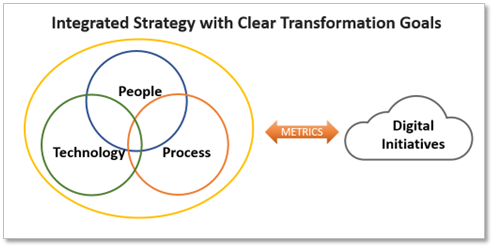Eva Schönleitner is a Senior Executive focused on applying leading edge technologies to enable breakthrough innovations in companies. Her expertise lies in the areas of commercialization, international expansion, and digitalization with focus on SAAS, cloud, and AI technologies. Throughout her 20-year career, Eva has held executive business roles at global IT and OT companies, her last role was CEO of a technology scale-up for real-time analytics and AI applications. Her hands-on experience in North America and Europe allows her to provide a unique view on cultural and operational differences. Eva now collaborates with VC and growth equity firms to advise technology and industrial companies, operates as interim CXO, and serves on boards as non-executive director. She splits her time between Seattle, US and Zurich, Switzerland.
Most companies have started working on digital initiatives, but it still seems difficult to execute them successfully. In 2019, 70% of companies failed in their digital transformation efforts1, one would think that 4 years later we have greatly improved…. but no. Latest research shows that these initiatives still fail at roughly the same rate!
Gartner assesses the risk of failure at 65%, KPMG at 73%, and one wonders why we have not learned from our previous experiences.
If digitalization initiatives are so prone to failure, why try? The reason is simple. Digital transformation can deliver superior productivity and an amazing competitive advantage.
The financial results companies achieved include:
- 8x higher earnings growth.
- 2x growth in enterprise value.
- Up to 2x EBITDA.
- And up to 10x in employee productivity 2.
Digital transformation initiatives typically come in three categories:
- Modernization of existing systems and processes.
- Enterprise-wide transformation across: Functions, Systems, and Processes.
- The creation of new business offerings and service models.
Initiatives either focus on cost optimization or new revenue generation. Many companies start with internal modernization, as it seems to be easiest, and then focus on new revenue streams. However, this is not always the case. A smaller number of companies create new digital offerings first, and then merge with the traditional business as part of an enterprise-wide transformation.
To steer your digital initiatives towards success, ask yourself the following questions:
- Are you being lured by new technologies?
New and exciting technologies are being launched at an ever-increasing rate; augmented reality, virtual reality, and digital twins; business in the metaverse; blockchain in finance and contracting; drones and autonomous guided vehicles in logistics; 3D printers in construction and manufacturing; and finally, the latest buzz, artificial intelligence creating hyper-accelerated analytical capabilities. Opportunities seem limitless when you even combine one or two.
A few suggestions to keep in mind when looking at new technologies so as not to get captivated by the promise of the new:
- Don’t jump from one technology to another without creating a cost/benefit list for each technology, be aware of the technical debt (aka historic older systems) but do not be a slave to it.
- Accept that the new “shiny toy” might not be the right one for your business, more importantly your organization may not be ready for it yet.
- Run many smaller pilot projects, compare them to a standard list of KPI’s. Be brutally honest with what doesn’t work or achieve the expected goals. Scale the “winners”, celebrate the successes even if they might be incremental, and repeat.
- Is there an over-arching digital strategy? Are you following it?
The point of digital transformation is to utilize new technologies to enhance your business model and offerings. So having a strategy that the organization can lean on during the transition is critical. It will guide the leadership teams towards the long-term goals and allow for the objective prioritization of projects to maximize the desired benefits. Be cognizant that those key criteria might not just be financial ones but also of an operational nature such as difficulty and time to implement.
- Are the CEO and the Board committed?
Digital transformation initiatives require top executive commitment up to the board level. They cannot be “skunk projects” if they’re supposed to gain global traction and innovate either internal processes or build new revenue streams. Executives provide overall guidance, review progress, highlight successes, but also keep the overall desired outcomes in view.
Executives also must be prepared to steer the course; not give up midway when an initiative gets tough, runs into timeline or budget issues, struggles with integration or interoperability issues, or requires enhancements as the transformation evolves. Backing the teams, educating, and navigating board expectations are key responsibilities that leadership including the CEO must perform to see a to successful digital transformation through.
- How to start?
Many digital initiatives start in the R&D or IT organizations to test new technologies, but digital transformation initiatives affect everyone. A broader set of stakeholders including functional experts, business units, vendors, and possibly customers need to be engaged. Including all main stakeholders from the beginning is a key success factor for the transformation.
Leading practice is to designate a small, centralized team comprised of technology and businesspeople. Assign top performers from your organizations, hire missing skillsets externally, and form a core team. It can try out the desired technologies, evaluate the viability for the business, and act as incubation experts to work with the rest of functions and businesses on the digital projects.
- Will the initiative scale?
Digital transformation will change companies in operations and on the sales side long-term; additional projects will continue to be identified as new technologies become available and the company identifies further digitalization opportunities. A solid and highly scalable, but also agile technical foundation is key to allow for future use cases that aren’t even known today.
A unified data platform with clear data governance is the technical backbone of enabling the multitude of use cases. Pitfalls on the technical side included ending up with siloed data, localized applications, and a lack of scalability. All of those are very painful – both for the users of the applications and the IT organization to maintain and grow. Starting out with a scalable but also flexible data platform is a must-do for long-term success of a digitalization initiative.
- Are you leaving people behind?
The core team has been created; how do you get the initiatives adopted across the company? This step is one where many companies stumble. Buy-in and involvement of the business units and functions throughout the project life is critical to successfully implementing a digital initiative. There are a several ways to create this environment including digital v-teams in each business, or the business/functional teams leading the initiatives and the small core team providing expert support.
- Have you considered the business processes?
The process side is the third cornerstone to consider throughout the implementation of digital initiatives and ongoing as they get adopted.
- Strong processes are needed throughout the implementation to lean on – especially as projects get tough. Part of the process is to have clearly defined targeted outcomes and related metrics for those outcomes. Be sure to define metrics that can be measured in your organization. Once defined: measure, measure, and measure more!
- Instill an agile governance model; one that can adjust over time, will fit multiple businesses, geographies, and functions. Like a siloed technology approach, a rigid governance model will stifle adoption and create resistance as it appears to be a blocker versus an enabler.
- As new digital initiatives get implemented, the business processes themselves will change. They need to get adjusted, stakeholder roles adjusted, and people trained in new approaches. Take the example of applying generative AI to a customer journey. Today your sales team might address all prospective customers as a first touch. Once implemented, a smart chatbot will be the first point of contact for certain customer inquiries, while your sales team can focus on higher qualified leads, enter at a later stage of the sales process, or focus on key target customer only.
- Is the team “digitalization experts” from Day 1?
One last thing to consider on your path to success is to start out “easy”.
Digital transformation is a new skillset for many companies; remember the consistent low success rates over the years. New skills need to be practiced before they become engrained as the “new normal”. An iterative approach, showing early successes, learning across projects and teams, and then accelerating what works in your organization is a pragmatic approach that will get you to the desired goals. Implement the “crawl – walk – run” principle, as it sets appropriate expectations with the stakeholders.
All those aspects might seem overwhelming at first, but implementing a digitalization effort successfully comes down to 3 key components:
- Creating an integrated strategy with clear transformation goals.
- Focusing on all three areas: technologies, people, and processes.
- Measure the progress and results of the initiatives.

Considering those components will increase the success rates on digital transformation initiatives significantly, giving companies the expected long-term results and inspiring us with innovative use cases.
References






